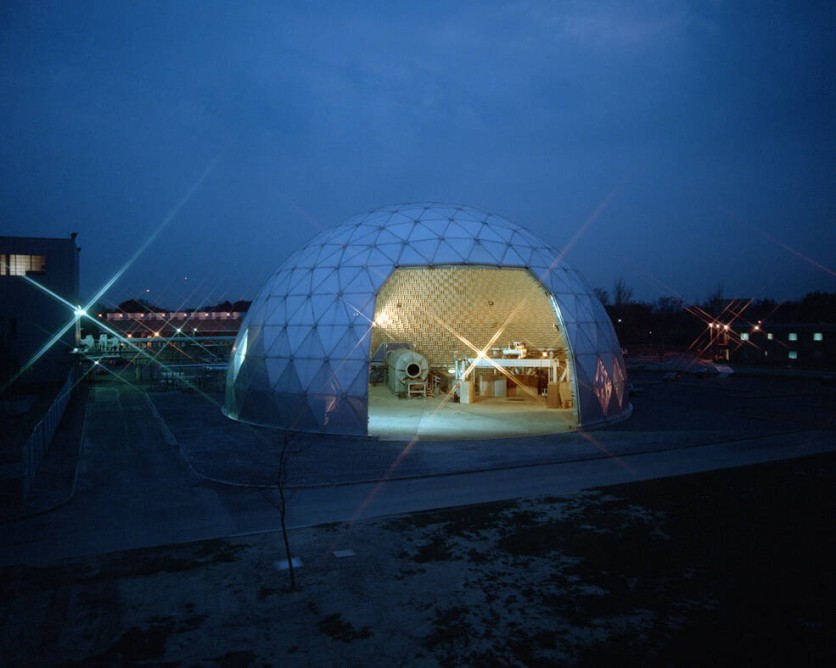NASA's Glenn Research Center has been an integral part of the nation's mission to reduce aircraft engine noise for over 70 years.
The center's journey in quieting jet engines has evolved into a pioneering effort, with its state-of-the-art Aero-Acoustic Propulsion Laboratory (AAPL) as a testament to its dedication.

NASA Glenn's 'The Dome'
Referred to as "the dome," the AAPL houses an array of test rigs enclosed within a spacious, sound-absorbing chamber. The impressive 130-foot diameter and 65-foot-high hemispherical structure stands as a distinctive feature on Glenn's campus.
The interior is adorned with spiky fiberglass wedges that dampen sound and an overhead microphone array capturing critical engine noise data.
NASA Glenn's focus on jet propulsion dates back to its inception as a National Advisory Committee for Aeronautics (NACA) laboratory in the 1940s.
The lab's contributions were pivotal in advancing the first generation of turbojet engines, a significant step toward the introduction of jet airliners in the mid-1950s.
However, jet aircraft were notably noisier than their piston-engine counterparts, prompting concerns from communities residing near airports. In response, Glenn's researchers embarked on noise reduction studies in the early 1950s.
To measure noise levels effectively, engines were mounted on simple steel stands, and microphones were strategically placed to capture sound data.
Surprisingly, researchers discovered that the primary noise source wasn't the engine's mechanical components but rather the interaction between the cold atmosphere and the high-speed stream of hot exhaust gases.
Consequently, investigations led to novel nozzle and ejector designs, addressing noise while considering their impact on engine performance and weight. The introduction of turbofan engines in the 1960s marked a significant milestone, offering both enhanced efficiency and reduced noise levels.
Despite this advancement, the demand for noise reduction persisted due to the proliferation of airliners, evolving aviation regulations, and growing interest in vertical and short-takeoff and landing (V/STOL) aircraft.
To address these challenges, NASA Glenn constructed a robust array of outdoor test stands in the late 1960s and early '70s, including three at the site where AAPL stands today.
The Powered Lift Facility (PLF), designed to study V/STOL concepts, was later added in 1986. Nonetheless, noise complaints from the local community led to the suspension of testing in 1989, according to NASA.
The need for further advancements persisted, prompting NASA Glenn's involvement in the High-Speed Research (HSR) program in 1990. The center designed the Nozzle Acoustic Test Rig (NATR), a wind tunnel for acoustic and aerodynamic nozzle testing.
Recognizing the inherent noise in this endeavor, the AAPL was established in 1991, a dome-shaped structure ensuring acoustic containment. The AAPL's Nozzle Acoustic Test Rig (NATR) played a central role in acoustic testing.
Alongside its contributions to the HSR program, it facilitated tests for the Advanced Subsonic Technology initiative and the first successful chevron nozzle trial in 1997.
Diversifying its capabilities, the Advanced Noise Control Fan (ANCF) rig and the Small Hot Jet Acoustic Rig (SHJAR) were introduced during the 1990s and 2000s. While the ANCF facilitated studies on acoustic liners and fan noise, the SHJAR handled scaled testing, offering advantages over the NATR.
Early 2000s
Entering the early 2000s, the AAPL underwent augmentation with the integration of a novel acoustic arena. This innovation facilitated concurrent tests across multiple rigs, encompassing the assessment of flyby and sideline noise.
Gradually, the utility of the Powered Lift Facility waned, culminating in its decommissioning in 2007. Likewise, the ANCF was substituted by the DGEN AeroPropulsion Research Turbofan (DART) rig in 2021, serving diverse research requirements.
Remaining a pivotal hub for NASA's testing initiatives, AAPL maintains its significance. Ongoing pursuits involve the correlation of noise data from scale-model nozzles within the facility with Learjet 25 flight test findings.
This venture aspires to elevate the predictive potential concerning takeoff noise for forthcoming supersonic commercial aircraft.
Related Article : NASA to Use Cutting-Edge Laser Technology for Psyche Asteroid Mission

ⓒ 2025 TECHTIMES.com All rights reserved. Do not reproduce without permission.




